Bulletin – September 2017 Payments The Growing Demand for Cash
- Download 852KB
Abstract
While survey data indicate that the share of Australian consumers' payments made with cash continues to fall, the number (and value) of banknotes in circulation continues to grow at around its trend pace of 6 per cent per year. This article discusses the reasons for these diverging trends, including: population, inflation and real income growth; a slower decline in total (rather than relative) cash payments; high cash users not captured by survey data; and the increasing stock of banknotes held for non-transactional purposes.
Introduction
Cash is an important element of the Australian payments system. Growth in the value of banknotes in circulation has been broadly steady at around 6 per cent per annum for more than a decade.[1] Currently, the total value of banknotes in circulation is around $74 billion (Graph 1). Growth is evident in all denominations, although growth in demand for the higher denominations has generally outpaced that of the lower denominations over the past 10 years.[2]
At the same time, evidence from the Reserve Bank's triennial Consumer Payments Survey (CPS) indicates that the share of payments (by number) made with cash has fallen substantially over the same period.[3] In 2007, around 70 per cent of consumer payments were made with cash. This fell to around 37 per cent in 2016 (Graph 2). In 2016, cards (debit and credit combined) overtook cash as the most common payment method.

Investigating the share of consumer payments made with cash is important for understanding consumer payment preferences. In isolation, however, it is difficult to draw inferences from these data regarding the value of banknotes required to meet the overall demand for cash, which also includes demand for cash from other transactional users (e.g. tourists and businesses) and as a store of value.
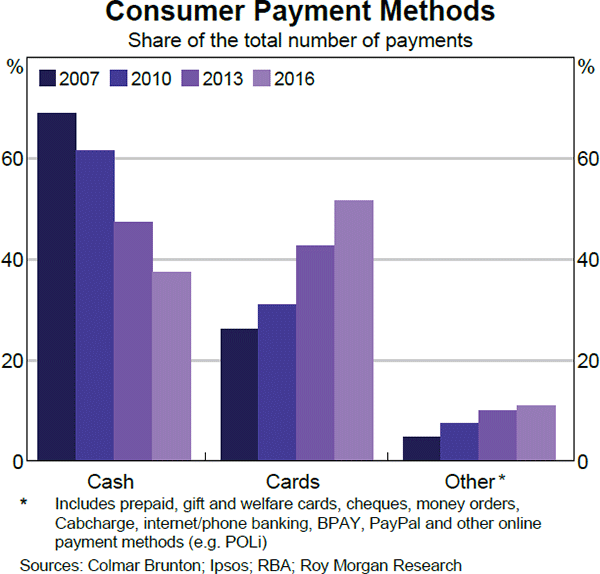
This article first discusses the factors influencing banknote demand over the long term, and then explores the reasons for the divergence between the continued growth of banknotes in circulation and the CPS results.
Long-term Drivers of Banknote Demand
Previous research by the Reserve Bank has found that the long-term determinants of banknote demand included the size of the Australian economy (nominal GDP), the interest rate and access to the payments system (the number of ATMs, EFTPOS machines and bank branches in Australia).[4] Updating this work using the latest data finds similar results (see Appendix A: Model 1).
The size of the economy is the most important driver of banknote demand, with a 1 per cent increase in nominal GDP associated with a 1 per cent increase in cash demand over the long term. While an increase in nominal GDP raises demand for all denominations, its impact is greatest on the higher denominations. Nominal GDP simultaneously captures the effect of population growth, inflation and real income growth, which suggests that these factors are important drivers of cash demand.
In fact, these three factors can explain much of the growth in circulation over the past 10 years. To see this, the value of banknotes in circulation can be adjusted to account for each factor (Graph 3). To begin with, the top line shows how the total value of banknotes in circulation has increased since 2007. The line immediately below adjusts this to account for Australia's increasing population. The next line incorporates the rate of inflation, and the final line accounts for the increase in real income per capita.
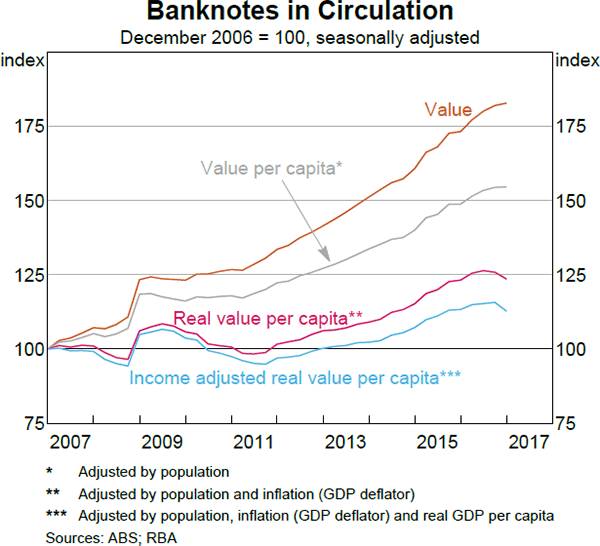
Compared with the total value of banknotes in circulation, the income adjusted real value of banknotes per capita in circulation has increased quite slowly over the past 10 years: around 1 per cent per annum, on average. This suggests that the value of banknotes in circulation has grown broadly in line with the Australian economy. Nevertheless, even this may seem surprising given the extent of the shift away from cash as a payment method indicated by the CPS.
Part of this is because we are comparing a variable in nominal terms (the dollar value of banknotes in circulation) with a variable expressed as a percentage share (the share of payments made with cash). This issue is addressed in the next section. The following section then expands upon the CPS results by exploring the transactional use of cash by groups other than Australian consumers. The final section considers the relationship between the stock of banknotes in circulation and the flow of payments made with cash.
The Total Value of Cash Payments
To make the CPS results comparable with the total value of banknotes in circulation, they need to be expressed in similar terms. While the CPS measures the percentage share of payments made with cash, circulation is a measure of the nominal (dollar) value of banknotes on issue. As such, circulation should be compared with the total value of cash payments rather than the share of payments made with cash.
The CPS data can be used to calculate each payment method's share of total payments by value (Graph 4). Cash payments comprise a smaller share of total payments when measured by value than by number. This is because cash is more commonly used in low-value payments. The share of cash payments by value has fallen since 2007, but was stable between 2013 and 2016 at around 18 per cent.
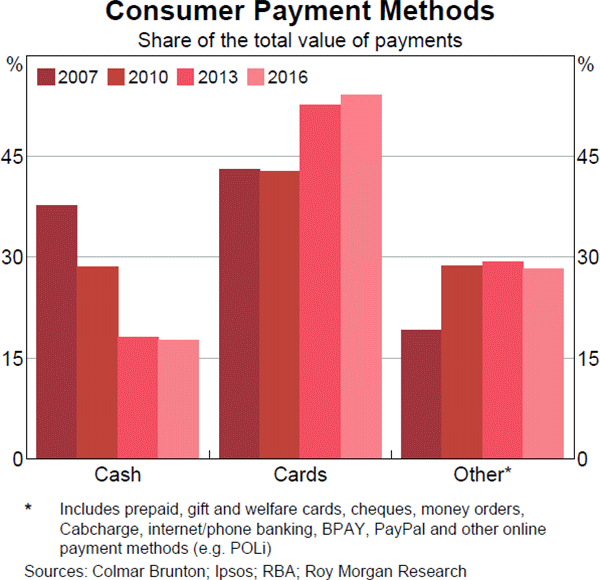
The total value of consumer cash payments can be estimated using the ratio of cash payments to card payments (from the CPS) and the value of consumer card payments in the economy (from the RBA's Retail Payment Statistics). Using this approach, total cash payments made by Australian consumers is estimated to have fallen by around one-quarter between 2007 and 2016 (Table 1).[5] Importantly, because total payments have increased – due to factors such as population, inflation and income growth – the fall in the total value of cash payments has not been as large as what is suggested by the changing share of cash payments, which declined by more than half.
| 2007 | 2010 | 2013 | 2016 | |
|---|---|---|---|---|
| Value of card payments ($ billion)(a) | 250 | 321 | 403 | 496 |
| Ratio of cash payments to card payments | 0.87 | 0.67 | 0.34 | 0.33 |
| Estimated value of cash payments ($ billion) | 218 | 214 | 139 | 162 |
|
(a) Excludes payments made using credit cards issued to businesses, but includes payments made using debits cards issued to businesses Sources: Colmar Brunton; Ipsos; RBA; Roy Morgan Research |
||||
Other Transactional Users of Cash
While the CPS measures the changing payment preferences of Australian consumers, it does not cover all users of Australian currency. Because of this, it might overstate the size of the decline in the total value of cash payments, particularly if other groups tend to use cash more often than the average Australian consumer. For example, the CPS does not cover cash use by businesses, nor is it likely to fully capture the use of cash in the shadow economy (e.g. to avoid reporting income to the authorities or to finance illicit activities).[6] Another important source of cash demand not captured by the CPS comes from overseas.
Foreign citizens and institutions may hold Australian banknotes for both transactional and non-transactional purposes. This is highlighted by the close relationship between the exchange rate and demand for the $100 banknote (Graph 5). This suggests that foreign citizens and institutions have a strong preference for the $100 banknote, most likely due to the lower transport and storage costs associated with holding higher-denomination banknotes.
The relationship between $100 banknote demand and the exchange rate can more formally be assessed using a regression framework (see Appendix A: Model 2). The full-sample model suggests that a 10 per cent depreciation in the value of the Australian dollar (relative to the US dollar) is associated with a cumulative increase in $100 banknote demand of around 1 per cent over a three-month period. Furthermore, the relationship appears to have strengthened since the global financial crisis, with a 10 per cent depreciation of the Australian dollar more recently associated with a 1.5 per cent rise in $100 banknote demand. Additionally, more of the variation in $100 banknote demand is explained by the exchange rate in the post-crisis period than the pre-crisis period.
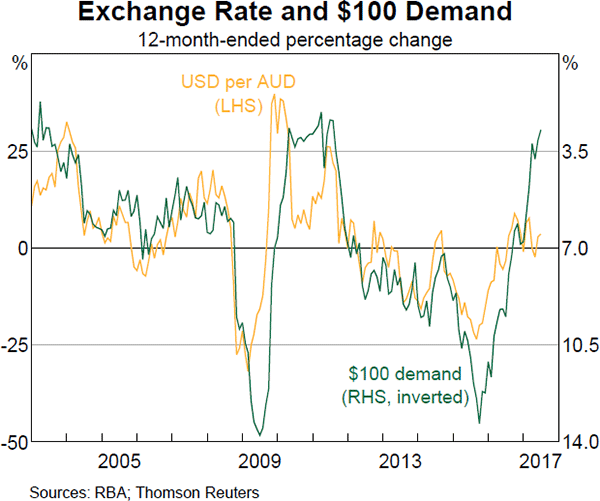
Foreign citizens who travel to Australia contribute to the transactional demand for Australian banknotes. Survey data on the spending patterns of overseas visitors, from Tourism Research Australia (TRA), can be used to estimate overseas visitors' payment preferences. Total expenditure has increased by around three-fifths since 2008 (Graph 6, left panel). The share of this that is attributable to card payments can be approximated using data on payments made with cards that were issued overseas.[7] Estimating cash expenditure as the residual (i.e. non-card payments) shows that the total value of cash payments by visitors has risen by more than two-fifths since 2008, with cash payments declining only slightly as a share of total expenditure.[8]
The TRA data can also be used to estimate where overseas arrivals obtain Australian banknotes.
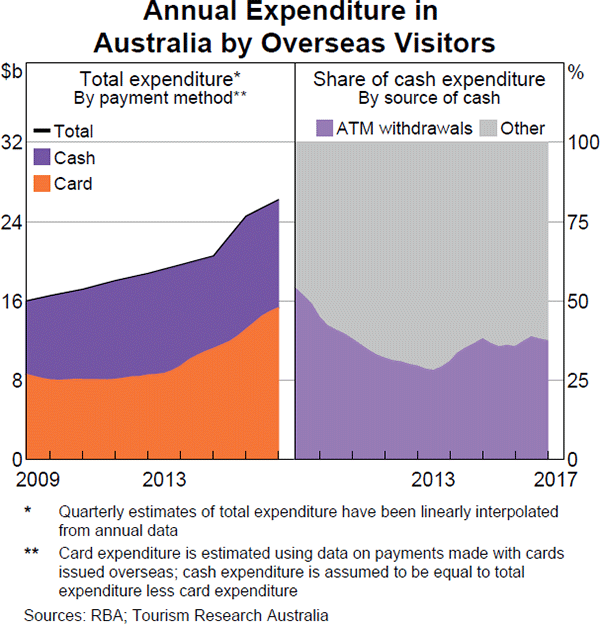
While cash expenditure by overseas visitors in 2016 is estimated to be around $11 billion, less than two-fifths of this was sourced through domestic ATMs using cards issued overseas (Graph 6, right panel). This is down from a share of around one-half in 2008. While some of the remaining cash could have come from other domestic sources (e.g. over-the-counter withdrawals, domestic foreign exchange retailers etc), it is likely that a large share of it is obtained prior to arrival in Australia. Liaison with foreign exchange companies suggests that cash is indeed often purchased before arrival in Australia.
These data suggest that overseas visitors are more likely to use cash than Australian consumers. This preference may be for a number of reasons including: the type of spending (e.g. a greater share of spending at restaurants and bars); the costs associated with overseas card use (e.g. international transaction fees); and the convenience of using cash when travelling (e.g. near universal acceptance). The changing composition of overseas visitors may also be a factor. The share of overseas arrivals from developing economies, which generally have higher cash use than advanced economies, has increased (Graph 7, left panel). Additionally, overseas student and tourist arrivals have also increased significantly (Graph 7, right panel). Liaison suggests that overseas students and tourists are relatively high cash users compared with the average Australian consumer.
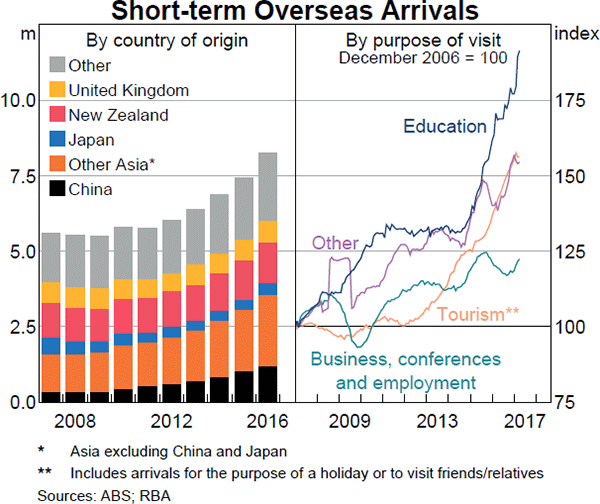
The Stock of Banknotes versus the Flow of Payments
While the value of banknotes in circulation and the value of cash payments are both measured in nominal (dollar) terms, they differ on another key aspect. This difference is illustrated using a stylised diagram of the banknote distribution system (Figure 1).[9] The value of banknotes in circulation is a stock. It measures the value of all banknotes held by the public – consumers, businesses, banks and overseas residents – at a particular point in time. In contrast, the value of cash payments is a flow. It measures the value of all payments made by consumers and overseas arrivals to businesses over a period of time.[10]
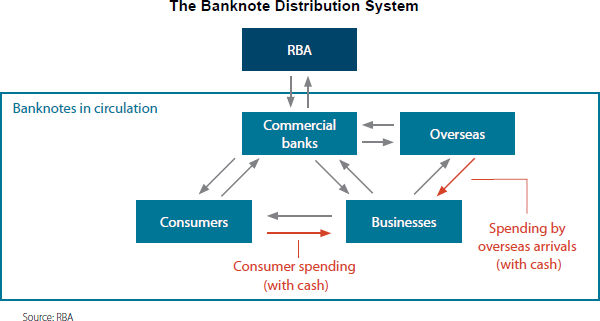
While the stock of banknotes in circulation and the flow of cash payments are related, there are important differences. A single banknote can be used in multiple cash payments. The average number of times that each banknote is used to make a payment in a given period of time is called the velocity of cash (Velocity). It relates the value of cash payments (Payments) to the value of banknotes in circulation (Circulation) via a simple equation:
The velocity of cash is not constant. It evolves with changes in technology, changes to the operation of the banknote distribution system, the stage of the business cycle, and consumer and business preferences. The rising stock of banknotes in circulation alongside declining cash payments suggests that the velocity of cash has fallen over the past 10 years. That is, each banknote in circulation is being used in fewer transactions now than in the past. Several factors have contributed to this, related to both the stock of banknotes held for transactional purposes and the stock held for store-of-value purposes.
Transactional stock
The transactional stock of banknotes – the stock of banknotes in the economy required to facilitate the flow of cash payments – is held in many different locations. These include wallets, cash registers, ATMs and other banknote-accepting and dispensing machines (e.g. self-service checkouts and ticketing machines). The velocity of cash will have slowed if the stock of cash held in such locations has increased (or remained constant) alongside falling cash transactions. This appears to have been the case given changes in the way consumers and businesses manage their holdings of cash.
Wallets
Consumers hold a stock of banknotes in their wallets to facilitate day-to-day payments. The CPS asked participants to record the value of banknotes held in their wallet at the start of the survey. While most respondents reported holding $100 or less in the 2016 wave of the survey, around 29 per cent reported that they held more than $100 (Graph 8). In fact, the average value of banknotes held in wallets has increased from $93 in 2010 to $101 in 2016.[11],[12] This has occurred despite cash being used in transactions less frequently.
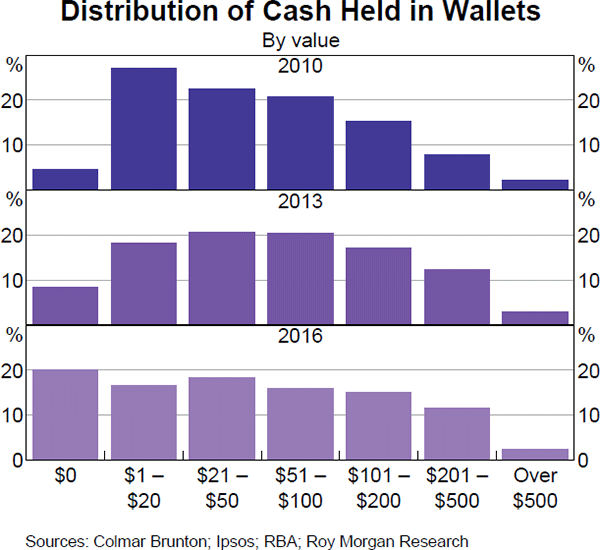
Cash registers
Cash registers hold a stock (a float) of banknotes in order to provide change. There are practical considerations that suggest there is a minimum level for this stock. Specifically, businesses must ensure that they are able to provide change to their cash-paying customers. This suggests that an increase in the number of cash registers in Australia since 2007 is likely to have led to an increase in the total value of cash held in cash registers. Alongside a decline in cash payments, this would have slowed the velocity of cash. Detailed data on the number of cash registers in Australia is not available but, assuming that most cash registers accept both cash and card payments, the number of EFTPOS terminals can be used as a proxy. The number of EFTPOS terminals has increased substantially since 2007 (Graph 9).
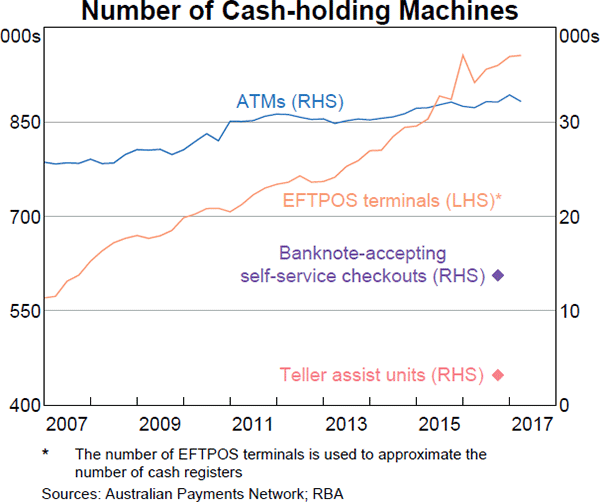
ATMs
ATMs hold a stock of banknotes to meet future withdrawals. While the expected value of future withdrawals is a factor which contributes to the decision on how to stock ATMs, practical considerations are also relevant. It is logistically challenging and costly to restock ATMs frequently, so they typically hold several days' worth of withdrawals. Further, some ATM operators have indicated that low interest rates have reduced the opportunity cost of holding banknotes. These factors have likely led to a rise in the value of banknotes held in ATMs, even as ATM withdrawals are falling.[13],[14] According to the Australian Payments Network, the number of ATMs in Australia has increased by around 26 per cent since 2007.[15]
Self-service checkouts
Self-service checkouts and other automated payment machines hold a stock of banknotes to provide change as well as banknotes that have been received as payment. Staff-operated cash registers recycle banknotes (i.e. use a banknote received in payment as change for the next customer). This is not generally the case for self-service checkouts, which typically hold cash received as payment separately from cash able to be dispensed as change. Recent advances in payment technology and consequent cost reductions have resulted in self-service checkouts and other automated payment machines becoming more prevalent. These have either replaced existing cash registers or increased the number of point-of-sale locations within those stores that use self-service checkouts. This has likely increased the number of banknotes used to facilitate the same number of payments. Based on surveys of the major banknote equipment manufacturers, it is estimated that at least 17,000 banknote-accepting self-service checkouts and teller assist units are in use in Australia.[16] Many other machines – such as ticketing machines, vending machines and smart safes – also hold a stock of cash.
Domestic store of value
In addition to its function as a means of payment, cash can also be held as a store of value. An increase in the value of banknotes held for store-of-value purposes necessarily reduces the velocity of cash because it has no effect on the value of cash payments. While accurately measuring cash held as a store of value is difficult, the available evidence suggests it is an important component of cash demand.
Around 70 per cent of participants in the 2016 CPS reported holding some cash outside of their wallet. The most common reason was for emergency transactions. Other reasons include ATM fees and withdrawal times, cash gifts and saving for large purchases.
The value of banknotes held outside of wallets varies greatly across consumers (Graph 10). Participants in the CPS were not asked to specify their exact cash holdings. Instead, they select which range of cash holdings they fall into from a set of pre-specified ranges. While most tend to hold less than $100, around 3 per cent of respondents reported holding amounts greater than $1,000, and 1 per cent hold more than $5,000 (the highest category).
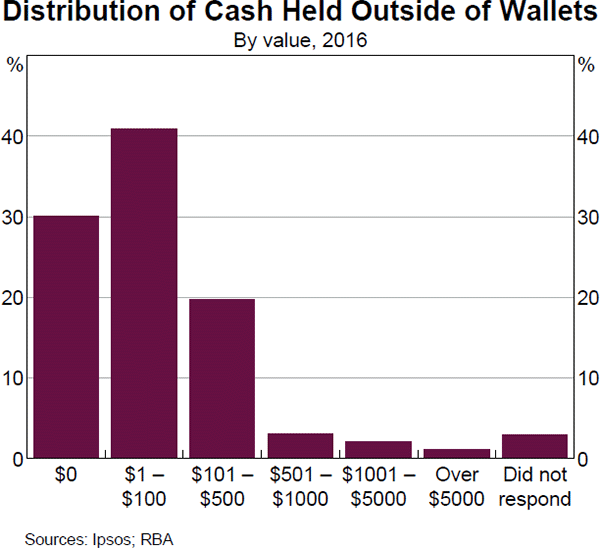
These results suggest that a large amount of wealth held in banknotes is concentrated in a relatively small number of households, which is broadly consistent with the distribution of wealth more generally. In fact, households with far greater stores of cash have been identified from damaged banknote claims received by the Reserve Bank over the past five years.[17] A number of claims where ‘house fire’ was cited as the cause of damage were in excess of $20,000. While the total value of banknotes being held as a domestic store of value is difficult to extrapolate from these data, it is clearly an important source of domestic cash demand. The data from these claims also provide some evidence that high-denomination banknotes are preferred for store-of-value holdings.
Macroeconomic factors since the financial crisis may have contributed to an increase in demand for banknotes held as a store of value. Firstly, heightened uncertainty may have increased demand for cash held for precautionary purposes. Secondly, low global and domestic interest rates have reduced the opportunity cost of holding cash over other assets. Model 1 (Appendix A) suggests that, over the long term, there is an inverse relationship between interest rates and cash demand. Finally, as with the transactional demand for cash, population growth, inflation and real income growth will increase underlying demand for cash held as a store of value.
Overseas store of value
Similar to domestic residents, foreign citizens and institutions may also hold Australian banknotes as a store of value. The reasons for doing so, however, are less clear. Overseas residents who frequently travel to Australia may hold a store of Australian currency instead of purchasing it each time they visit. Policy settings in their home country may also diminish the incentive to hold their domestic currency as a store of value; for example, if the value of the currency is volatile due to high inflation or unexpected exchange rate fluctuations. There is evidence to suggest that the expectation of a depreciation of the Chinese yuan is associated with an increase in demand for the Australian $100 banknote (see Appendix A: Model 2).
Conclusion
Australian consumers are increasingly choosing to make payments with cards rather than cash. Despite this, the value of banknotes in circulation continues to grow broadly in line with its long-term trend, with all denominations showing positive growth. Several factors help to reconcile these contrasting trends.
Firstly, continued growth in the Australian economy has supported the transactional demand for cash. As a result, the total value of Australian consumers' cash payments has not fallen as steeply as the share of payments made with cash. Secondly, other users of Australian currency, most notably overseas visitors such as tourists and students, have contributed to the growing demand for cash.
Finally, the velocity of cash has slowed. This partly relates to the increasing prevalence of banknote-accepting and dispensing machines. While the use of this equipment is cost effective for retailers, particularly given the current low opportunity cost of holding cash, it increases the number of banknotes required to service any individual transaction. Increasing demand for cash held as a store of value has also slowed the velocity of cash.
Appendix A
Model 1
We re-estimate the general error-correction model proposed by Cusbert and Rohling (2013):
where ct is the stock of cash in circulation in period t and Xt is a vector of variables including nominal GDP, the deposit interest rate, ATMs per capita, EFTPOS terminals per capita and bank branches per capita. All variables except the interest rate are in logarithms. Where necessary, variables have been seasonally adjusted. Dummy variables were also included in the model to account for structural changes in cash demand due to changes in the banknote distribution system and the global financial crisis. The parameters to be estimated are the vector of long-run parameters β1, the speed of adjustment parameter λ, and the parameters for the dynamic term δi and γj. The error term is εt.
For total circulation, and separately for each denomination, we estimate this model using quarterly data from March 1993 to June 2016. Table A1 presents the results of the estimated models. The constant and dummy variables have been excluded from the table for brevity. Of the dynamic terms, only the first lag of the change in the stock of $100 banknotes in circulation is significant so it is the only dynamic term retained.
| Variable | $5 | $10 | $20 | $50 | $100 | Total |
|---|---|---|---|---|---|---|
| Speed of adjustment (λ) | −0.22*** (0.04) | −0.30*** (0.06) | −0.18*** (0.05) | −0.24*** (0.04) | −0.07*** (0.02) | −0.13*** (0.04) |
| GDPt−1 (β1) | 0.69*** (0.03) | 0.58*** (0.02) | 0.29*** (0.05) | 0.88*** (0.03) | 1.20*** (0.08) | 1.01*** (0.05) |
| DepositRatet−1(β2) | −0.02* * * (0.00) | – | −0.02*** (0.00) | −0.03** (0.01) | −0.02*** (0.00) | |
| ATMt−1(β3) | – | – | 0.18* (0.11) | 0.09 (0.06) | – | – |
| EFTPOSt−1(β4) | −0.06* * (0.02) | −0.06*** (0.01) | −0.08** (0.03) | 0.07*** (0.02) | −0.24*** (0.08) | −0.10** (0.04) |
| BankBranchest−1(β5) | −0.44* * * (0.13) | – | – | −1.06*** (0.39) | −0.61*** (0.21) | |
 |
– | – | 0.57*** (0.10) | – | ||
| Summary statistics(c) | ||||||
| Adjusted R2 | 0.27 | 0.26 | 0.19 | 0.47 | 0.62 | 0.35 |
| SD of dependent variable | 0.013 | 0.013 | 0.018 | 0.012 | 0.011 | 0.008 |
| SE of regression | 0.011 | 0.011 | 0.016 | 0.009 | 0.007 | 0.006 |
|
(a) ***, ** and * indicate significance at the 1, 5 and 10 per cent
level, respectively; ‘–’ indicates that the variable
was not significant and was removed from estimation Sources: ABS; APRA; Australian Payments Network; RBA |
||||||
Model 2
The distributed lag model used to estimate the relationship between $100 demand and the exchange rate is:
where ct is the seasonally adjusted value of $100 banknotes in circulation in period t, USDt is the AUD/USD exchange rate and RiskReversalt is the CNY 25 delta 1-month risk reversal (a measure of expectations of a depreciation in the yuan). All variables except the risk reversal are in logarithms. Dummy variables were also included in the model to account for volatility at the time of the global financial crisis. The parameters to be estimated are α, δi, and β. The error term is εt. The full-sample model was estimated using monthly data from November 2003 to December 2016. Sub-samples were used to estimate the pre- and post-crisis models.
Table A2 presents the results of the estimated models. The dummy variables are excluded for brevity. The chosen lag lengths were based on parameter significance and the Schwarz criterion.
| Variable | Full sample Nov 03 to Mar 17 | Pre-crisis Nov 03 to Jul 08 | Post-crisis Jan 10 to Mar 17 |
|---|---|---|---|
| Constant (α) | 0.01*** (0.00) |
0.01*** (0.00) |
0.01*** (0.00) |
| ΔUSDt (δ0) | −0.02* (0.01) |
−0.02* (0.01) |
−0.04*** (0.01) |
| ΔUSDt−1 (δ1) | −0.04*** (0.01) |
−0.04** (0.02) |
−0.07*** (0.01) |
| ΔUSDt−2 (δ2) | −0.03*** (0.01) |
−0.02* (0.01) |
−0.03** (0.01) |
| RiskReversalt (β) | 0.08*** (0.02) |
0.03 (0.02) |
0.10*** (0.03) |
| Summary statistics(c) | |||
| Adjusted R2 | 0.30 | 0.10 | 0.48 |
| SD of dependent variable | 0.004 | 0.003 | 0.004 |
| SE of regression | 0.003 | 0.003 | 0.003 |
|
(a) ***, ** and * indicate significance at the 1, 5 and 10 per cent level, respectively Sources: Bloomberg; RBA; Thomson Reuters |
|||
Footnotes
The authors are from the Note Issue Department. [*]
The exception was during the global financial crisis when the growth in banknotes in circulation, particularly high-denomination banknotes, was considerably higher than the long-term trend. [1]
The pick-up in growth in the lower denominations over the past year largely reflects the introduction of the new $5 banknote in September 2016, with the previous series $5 banknote also remaining in circulation. [2]
The Reserve Bank has conducted a survey of consumer payments every three years since 2007. See Emery, West and Massey (2007); Bagnall, Chong and Smith (2011); Ossolinski, Lam and Emery (2014); Doyle et al (2017a); and Doyle et al (2017b). [3]
See Cusbert and Rohling (2013). The method outlined by Cusbert and Rohling was also replicated by the Bank of England, who found similar results (Miller 2017). [4]
Precisely estimating the total value of consumer cash payments is difficult. While the method applied here is useful for gauging the direction and magnitude of the change in the value of cash payments, the exact values shown in Table 1 should be treated with caution. [5]
Cash use by businesses and those who operate in the shadow economy are not discussed in detail in this article. [6]
This may overstate card payments as it will include some card-not-present transactions (e.g. online payments where card details were supplied) made from overseas. Such payments would not be included in the TRA expenditure data. [7]
This may overstate cash expenditure because: i) international visitors may use payment methods other than card or cash; and ii) overseas visitors who are in Australia for a prolonged period of time, such as those here for education or employment, may open an Australian bank account from which non-cash payments can be made. [8]
For further information on banknote distribution arrangements, see Cowling and Howlett (2012). [9]
Other payment types also occur (e.g. consumer-to-consumer, business-to-business), though we do not discuss these here for brevity. [10]
The number and value of banknotes held in participants' wallets was not asked in 2007. In 2013, the average value of banknotes held in consumers' wallets was $112. [11]
This excludes survey participants who reported holding more than $10,000 in their wallets. If included, the 2010 and 2013 averages are unchanged, but the 2016 average increases to $118. [12]
In 2007, $145 billion was withdrawn from ATMs in Australia. This fell to $135 billion in 2016. [13]
The results of Model 1 (Appendix A) provide some support for this, suggesting that a 1 per cent increase in the number of ATMs per capita leads to a 0.2 per cent increase in the number of $20 banknotes in circulation and a 0.1 per cent increase in the number of $50 banknotes in circulation. The result is not statistically significant for the $50, though this is sensitive to the choice of income measure in the regression. The economic and statistical significance increases for both denominations when gross national income or household disposable income is used in place of GDP. [14]
The Australian Payments Network was formerly known as the Australian Payments Clearing Association. [15]
Teller assist units are increasingly used by staff in bank branches to dispense banknotes rather than cash drawers. [16]
The Reserve Bank offers a Damaged Banknotes Facility designed to reimburse members of the public whose banknotes have been accidentally damaged, with the aim of ensuring that they do not face financial hardship. [17]
References
Bagnall J, S Chong and K Smith (2011), ‘Strategic Review of Innovation in the Payments System: Results of the Reserve Bank of Australia's 2010 Consumer Payments Use Study’, Sydney.
Cowling A and M Howlett (2012), ‘Banknote Quality in Australia’, RBA Bulletin, June, pp 69–75.
Cusbert T and T Rohling (2013), ‘Currency Demand during the Global Financial Crisis: Evidence from Australia’, RBA Research Discussion Paper No 2013–01.
Doyle M-A, C Fisher, E Tellez and A Yadav (2017a), ‘How Australians Pay: New Survey Evidence’, RBA Bulletin, March, pp 59–66.
Doyle M-A, C Fisher, E Tellez and A Yadav (2017b), ‘How Australians Pay: Evidence from the 2016 Consumer Payments Survey’, RBA Research Discussion Paper No 2017–04.
Emery D, T West and D Massey (2007), ‘Household Payment Patterns in Australia’, Payments System Review Conference, Proceedings of a Conference, Reserve Bank of Australia, Sydney, pp 139–176.
Miller C (2017), ‘Addressing the Limitations of Forecasting Banknote Demand’, International Cash Conference, Proceedings of a Conference, The Deutsche Bundesbank, Island of Mainau.
Ossolinski C, T Lam and D Emery (2014), ‘The Changing Way We Pay: Trends in Consumer Payments’, RBA Research Discussion Paper No 2014–05.


